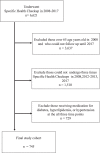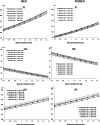Change in waist circumference and lifestyle habit factors as a predictor of metabolic risk among middle-aged and elderly Japanese people: population-based retrospective 10-year follow-up study from 2008 to 2017
- PMID: 35264230
- PMCID: PMC8905753
- DOI: 10.1186/s13690-022-00836-z
Change in waist circumference and lifestyle habit factors as a predictor of metabolic risk among middle-aged and elderly Japanese people: population-based retrospective 10-year follow-up study from 2008 to 2017
Abstract
Background: Waist circumference (WC) increases more than body mass index (BMI) over time. This study investigated the change in WC among middle-aged and elderly Japanese people for 10 years, and its relationship with lifestyle and lipid metabolism factor.
Methods: Health checkup data and lifestyle habits of a retrospective cohort of 745 people aged 40-65 years who underwent health checkups at least three times between 2008 and 2017 were analyzed. Information of Lifestyle habits about smoking history, regular exercise, alcohol intake skipping breakfast was collected using a self-administered questionnaire. Participants who were taking medications for diabetes, hyperlipidemia, or hypertension were excluded from analyses. Longitudinal associations between the change in WC and lifestyle habit factors with adjustments for sex, age, and WC at the start of health checkups were assessed using generalized linear models.
Results: Regardless of lifestyle, body weight (BW) decreased 0.8 kg (p < 0.001) for women, 0.9 kg (p = 0.003) for men, WC increased 0.8 cm (p = 0.007) for women, 0.2 cm (p = 0.657) for men. In addition, serum triglycerides and high- and low-density lipoprotein levels estimated 10 years later revealed that increased WC ratios also exacerbated the respective blood sample data.
Conclusion: Both men and women showed an increase in WC regardless of BW changes, and the increase in WC worsened lipid metabolism. For the middle-aged and elderly, whose WC increases over time, it will be more important to take notice of their WC than BW or BMI for effective health checkups.
Keywords: Health checkup; Lifestyle habits; Waist circumference.
© 2022. The Author(s).
Conflict of interest statement
The authors declare that they have no competing interests in relation to this manuscript.
Figures



Similar articles
-
Skipping breakfast and 5-year changes in body mass index and waist circumference in Japanese men and women.Obes Sci Pract. 2017 Apr 3;3(2):162-170. doi: 10.1002/osp4.106. eCollection 2017 Jun. Obes Sci Pract. 2017. PMID: 28702211 Free PMC article.
-
Effect of Regular Exercise and Functional Beverages on Changes in Body Weight and Waist Circumference in Healthy Japanese Subjects.Medicina (Kaunas). 2018 Sep 4;54(4):64. doi: 10.3390/medicina54040064. Medicina (Kaunas). 2018. PMID: 30344295 Free PMC article.
-
Waist circumference is a better predictor of risk for frailty than BMI in the community-dwelling elderly in Beijing.Aging Clin Exp Res. 2018 Nov;30(11):1319-1325. doi: 10.1007/s40520-018-0933-x. Epub 2018 Mar 27. Aging Clin Exp Res. 2018. PMID: 29589287
-
Is waist circumference a useful measure in predicting health outcomes in the elderly?Int J Obes Relat Metab Disord. 2002 Oct;26(10):1349-55. doi: 10.1038/sj.ijo.0802080. Int J Obes Relat Metab Disord. 2002. PMID: 12355330
-
Offspring body size and metabolic profile - effects of lifestyle intervention in obese pregnant women.Dan Med J. 2014 Jul;61(7):B4893. Dan Med J. 2014. PMID: 25123127 Review.
Cited by
-
Lifestyle factors as mediators of area-level socio-economic differentials in cardiovascular disease risk factors. The Tromsø Study.SSM Popul Health. 2022 Sep 24;19:101241. doi: 10.1016/j.ssmph.2022.101241. eCollection 2022 Sep. SSM Popul Health. 2022. PMID: 36203474 Free PMC article.
-
The pathophysiology of visceral adipose tissues in cardiometabolic diseases.Biochem Pharmacol. 2024 Apr;222:116116. doi: 10.1016/j.bcp.2024.116116. Epub 2024 Mar 8. Biochem Pharmacol. 2024. PMID: 38460909 Free PMC article. Review.
-
The Trends of Medical Care Expenditure with Adjustment of Lifestyle Habits and Medication; 10-Year Retrospective Follow-Up Study.Int J Environ Res Public Health. 2020 Dec 20;17(24):9546. doi: 10.3390/ijerph17249546. Int J Environ Res Public Health. 2020. PMID: 33419363 Free PMC article.
References
-
- Ministry of Health, Labour and Welfare. The National Health and Nutrition Survey in Japan. Tokyo, Japan. WWW document. 2019. URL http://www.mhlw.go.jp/stf/seisakunitsuite/bunya/kenkou_iryou/kenkou/eiyo....html. Accessed 29 Sep 2021.
Grants and funding
LinkOut - more resources
Full Text Sources

